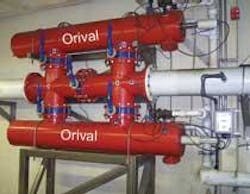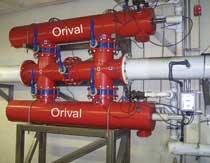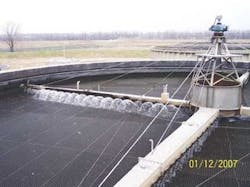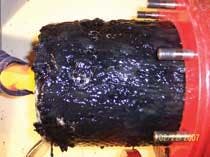Filtration System Stands up to Trickling Filter Sludge Challenge
by Marcus N. Allhands
Wastewater treatment plants have a variety of processes and systems that require water for washing and cooling systems. Using recycled wastewater for those processes is a growing trend as utilities attempt to reduce demand for potable water.
Water is often used for automatic cleaning devices on primary bar screens in a plant headworks. At the other end of the plant, belt presses used to dewater sludge need a steady supply of spray water to keep the belts clean and porous. Pumps of various horsepower, configuration and brands are often scattered throughout a treatment facility. Many of these have seals that must be drenched in water throughout their duty cycle. This water must be absent of any particulates that could cause scaring or erosion of shafts and seals. And, service water at hose bibs and equipment wash stations need not use valuable potable water.
Various filter manufactures have proven their equipment on effluent from a typical activated sludge treatment process. However, a recent project at a facility that uses a tricking filter system proved to be challenging because of various operational issues.
While activated sludge is made up of myriads of individual organisms that float around independent of other individuals, the trickling filter process produces large colonies of organisms that exist together in a bio-film mass attached to the filter’s packing or media. This bio-film periodically sloughs off the media in large globs that do not settle as uniformly in a clarifier. Therefore, the suspended solids in the effluent from a trickling filter process tend to be more of a stringy, slimy, globular consistency than activated sludge effluent.
In a recent project at a Midwestern facility, the engineering firm involved decided on automatic self-cleaning filters with 150 micron stainless steel weave-wire screens to make the effluent acceptable for reuse. Two 12 inch Orival Model OR-12-PS automatic self-cleaning filters were manifolded together to operate in parallel to provide sufficient capacity in a small area.
The filters automatically clean themselves by backwashing a few distinct dime-size areas of the screen and then moving those areas over the entire screen surface. This technology has two strong attributes: the entire screen area gets cleaned during each cleaning cycle and filters do not have to come off-line to clean; thereby, supplying filtered water downstream even while self-cleaning.
Upon initial start-up of this filtration system a number of problems arose.
The dual-filter system began to experience clogged screens in a matter of minutes after start-up. The filters automatically signal a cleaning cycle when either a 7 psi pressure differential is sensed across the filters or an adjustable preset timer has expired. As long as the differential pressure switch remains closed, the filter will repeat cleaning cycles until a preset number of cycles has been reached and then the controller will shut down the cleaning process to prevent dumping too much water to drain and send a fault signal. This signal was being activated repeatedly.
When the filters were opened for inspection the screens were found to be completely encased in a black, stringy, tarry sludge that even plugged the large 3/8" holes in the coarse protective screen. Further investigation showed a layer of sludge 12-15 inches thick had built up on the floor of the basin from which the pumps supplying the filters drew effluent. The vertical turbine pump inlets were located about 6" off the floor of the basin.
Screen filters are not sludge filters. A vacuum truck was called to remove the sludge layer. After pumping resumed from the cleaned basin, the filters worked as expected, with cleaning cycles triggered by the timer every two hours.
Had the original engineers investigated a little further in the preliminary design stage they would have realized that an old coarse-screen continuous cleaning filter had been operating in this area for many years. But instead of flushing the debris it captured back to the head-works of the treatment plant, it dumped the debris back into the basin from which it received its effluent. Decades of accumulated solids had built up inside the basin forming the dense sludge layer encountered by the new filtration system.
It was soon noted that two or more consecutive cleaning cycles caused air pressure to build up in the drain line. At one point, the vice president of the filter manufacturing company was completely soaked with treated but unchlorinated effluent when a clamped rubber joint in the drain line blew apart while he was training plant personnel on the filtration system.
The situation occurred because the 6" drain line from the filters traveled underground about 150 feet to a wet well about 5 feet in diameter. Inside the wet well were two, 2" residential basement-type sump pumps. Both 2" discharge lines were tied together into a single 2" line leaving the wet well. This greatly decreased the pump-down capacity of the wet well system. One flush of the filtration system would raise the water level in the wet well above the drain inlet elevation, completely submerging the 6" inlet drain pipe.
It took the two sump pumps 8½ minutes to remove the water resulting from a single filter flush cycle. If a second filter cleaning cycle should occur within 8½ minutes of the last cycle (which often occurs during training sessions) pressure would build up in the drain line and blow apart a joint or create enough back-pressure in the filter cleaning mechanism to prevent effective screen cleaning.
The solution for this situation was to provide pressure relief in the drain line so that if the outlet in the wet well was submerged, water could overflow back into the basin from which the effluent came. This is intended to rarely happen or it will be back to pre-improvement conditions with another sludge buildup.
All is now working well with phase one of the renovation, with reuse running 800 -1000 gpm. Having had no experience with trickling filter effluent, engineers at the filter manufacturer made their design recommendation on activated sludge effluent. This was adequate for phase one flow rates but success of phase two when flows reach 2000 gpm is expected but not guaranteed. Additional screen filtration area may be necessary when flows double. This can be accomplished by simply installing a duplicate system in parallel with the existing one. Space is available in the pump room and the existing controller will integrate both dual units into a single operating system.
About the Author:
Marcus N. Allhands, PhD, PE, is Vice President of Business Development at Orival Inc. Dr. Allhands received his engineering BS from Purdue University and his PhD from the University of Florida. He is a registered professional engineer in Illinois and Florida. Allhands spent seven years as Water Quality Manager of an engineering and environmental consulting firm in southwest Florida and then ten years as Senior Application Engineer for an international filtration company. He may be contacted via e-mail at [email protected].



